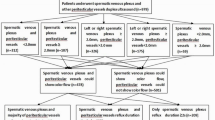Abstract
Objectives
We have attempted to determine the incidence of venous reflux detected by color Doppler in varicoceles of various grades evaluated during a physical examination.
Patients and methods
The data of patients referred to our outpatient clinic between 1997 and 2007 with the diagnosis of varicocele due to complaints of scrotal pain, palpable swelling or infertility were retrospectively reviewed. The presence of venous reflux was compared with the grade of varicoceles during a physical examination.
Results
A total of 802 male patients with a mean age of 27.1 years (range 16–52 years) were included in this study. Of these, physical examination reviewed that ten (1.2%), 72 (9.0%), 433 (54.0%) and 287 (35.8%) patients had grade 0, 1, 2 or 3 varicoceles, respectively, on the left side and that 607 (75.7%), 73 (9.1%), 108 (13.5%) and 14 (1.7%) patients had grade 0, 1, 2 or 3 varicoceles, respectively, on the right side. Color Doppler examination revealed venous reflux in three (30.0%) grade 0 testicular units, 63 (87.5%) grade 1 testicular units, 400 (92.4%) grade 2 testicular units and 273 (95.1%) grade 3 testicular units on the left side and venous reflux in 99 (16.3%) grade 0 testicular units, 54 (73.6%) grade 1 testicular units, 88 (81.5%) grade 2 testicular units and 12 (85.7%) grade 3 testicular units on the right side. Physical examination did not reveal any statistically significant correlation between the incidence of venous reflux and the grade of the clinically evident varicoceles for both sides.
Conclusions
For assessing the severity of clinically evident varicoceles, the clinician should not use venous reflux as the sole predictor because of its high incidence in all grades of varicoceles. Additional measurements, such as flow volume, duration and velocity of reflux, are recommended as diagnostic tools for assessing the severity of varicocele more accurately.

Similar content being viewed by others
References
Cornud F, Belin X, Amar E et al (1999) Varicocele: strategies in diagnosis and treatment. Eur Radiol 9(3):536–545
Meacham R, Townsend R, Rademacher D et al (1994) The incidence of varicoceles in the general population when evaluated by physical examination, grey-scale sonography, and colour Doppler sonography. J Urol 151:1535–1538
Brown JS, Dubin L, Becker M et al (1967) Venography in the subfertile man with varicocele. J Urol 98(3):388–392
Dubin L, Amelar RD (1971) Etiologic factors in 1294 consecutive cases of male infertility. Fertil Steril 22(8):469–474
Chiou RK, Anderson JC, Wobig RK et al (1997) Color Doppler ultrasound criteria to diagnose varicoceles: correlation of a new scoring system with physical examination. Urology 50(6):953–956
Hoekstra T, Witt M (1995) The correlation of internal spermatic vein palpability with ultrasonographic diameter and reversal of venous flow. J Urol 153:82–84
Dhabuwala C, Kumar A, Kerkar P et al (1989) Patterns of Doppler recordings and its relationship to varicocele in infertile men. Int J Androl 12:430–438
Aydos K, Baltaci S, Salih M et al (1993) Use of color Doppler sonography in the evaluation of varicoceles. Eur Urol 24(2):221–225
Kocakoc E, Serhatlioglu S, Kiris A et al (2003) Color Doppler sonographic evaluation of inter-relations between diameter, reflux and flow volume of testicular veins in varicocele. Eur J Radiol 47(3):251–256
Marsman JW (1985) Clinical versus subclinical varicocele: venographic findings and improvement of fertility after embolization. Radiology 155(3):635–638
Jarow JP, Ogle SR, Eskew LA (1996) Seminal improvement following repair of ultrasound detected subclinical varicoceles. J Urol 155(4):1287–1290
Kocakoc E, Kiris A, Orhan I et al (2002) Incidence and importance of reflux in testicular veins of healthy men evaluated with color duplex sonography. J Clin Ultrasound 30(5):282–287
Turek P, Lipshultz L (2005) The varicocele controversies II. Diagnosis and treatment. AUA Update Series 14:112–119
Author information
Authors and Affiliations
Corresponding author
Rights and permissions
About this article
Cite this article
Zumrutbas, A.E., Resorlu, B., Yesil, M. et al. Is the presence of venous reflux really significant in the diagnosis of varicocele?. Int Urol Nephrol 40, 983–987 (2008). https://doi.org/10.1007/s11255-008-9397-9
Received:
Accepted:
Published:
Issue Date:
DOI: https://doi.org/10.1007/s11255-008-9397-9




